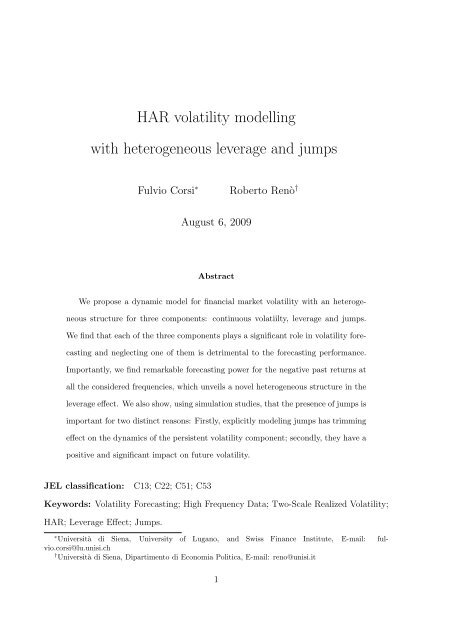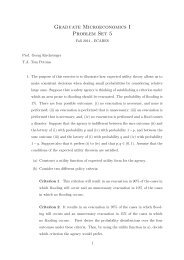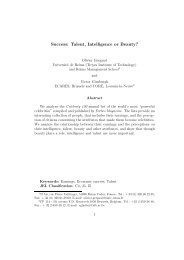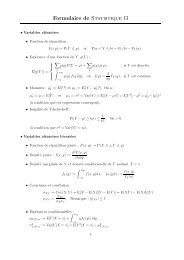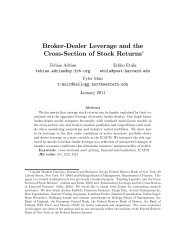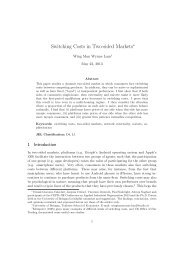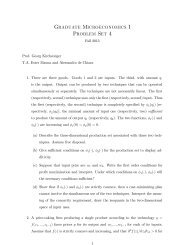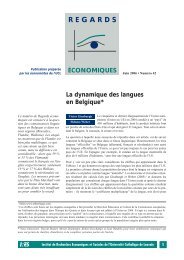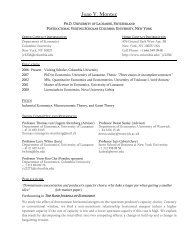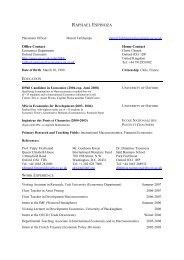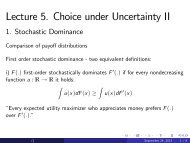HAR volatility modelling with heterogeneous ... - ResearchGate
HAR volatility modelling with heterogeneous ... - ResearchGate
HAR volatility modelling with heterogeneous ... - ResearchGate
You also want an ePaper? Increase the reach of your titles
YUMPU automatically turns print PDFs into web optimized ePapers that Google loves.
<strong>HAR</strong> <strong>volatility</strong> <strong>modelling</strong><strong>with</strong> <strong>heterogeneous</strong> leverage and jumpsFulvio Corsi ∗ Roberto Renò †August 6, 2009AbstractWe propose a dynamic model for financial market <strong>volatility</strong> <strong>with</strong> an <strong>heterogeneous</strong>structure for three components: continuous volatiilty, leverage and jumps.We find that each of the three components plays a significant role in <strong>volatility</strong> forecastingand neglecting one of them is detrimental to the forecasting performance.Importantly, we find remarkable forecasting power for the negative past returns atall the considered frequencies, which unveils a novel <strong>heterogeneous</strong> structure in theleverage effect. We also show, using simulation studies, that the presence of jumps isimportant for two distinct reasons: Firstly, explicitly modeling jumps has trimmingeffect on the dynamics of the persistent <strong>volatility</strong> component; secondly, they have apositive and significant impact on future <strong>volatility</strong>.JEL classification: C13; C22; C51; C53Keywords: Volatility Forecasting; High Frequency Data; Two-Scale Realized Volatility;<strong>HAR</strong>; Leverage Effect; Jumps.∗ Università di Siena, University of Lugano, and Swiss Finance Institute, E-mail: fulvio.corsi@lu.unisi.ch† Università di Siena, Dipartimento di Economia Politica, E-mail: reno@unisi.it1
1 IntroductionThe importance of financial market <strong>volatility</strong> led to a very large literature in which <strong>volatility</strong>dynamics has been modelled to take into accunt its most salient features (clustering,slowly decaying auto-correlation, asymmetric responses). This paper contributes to thisliterature by proposing a reduced form discrete-time model in which, after separatingquadratic variation in the continuous and jumps part, 1 <strong>volatility</strong> is assumed to depend onthree components: continuous <strong>volatility</strong>, negative returns and jumps. In order to reproducethe persistent impact of each component observed in the data, we impose a common<strong>heterogeneous</strong> structure. In particular, while it is well known that <strong>volatility</strong> tends toincrease more after a negative shock than after a positive shock of the same magnitude,see Christie (1982); Campbell and Hentschel (1992); Glosten et al. (1989) and more recentlyBollerslev et al. (2006), we provide novel evidence on the fact that the impact ofnegative returns on future <strong>volatility</strong> (the so-called leverage effect) is also highly persistentand extends for a period of at least one month.In Corsi (2009) a simple Heterogeneous Auto-Regressive (<strong>HAR</strong>) model has been proposedfor realized <strong>volatility</strong> to capture the empirical memory persistence of <strong>volatility</strong> in a simpleand parsimonious way. In this paper, we propose an extended version of the <strong>HAR</strong> modelwhich considers asymmetric responses of the realized <strong>volatility</strong> not only to previous dailynegative returns, but also to their weekly and monthly aggregation. Our main contributionis then to show that the <strong>heterogeneous</strong> structure applies to the leverage effect as well, thusreinforcing the Heterogeneous Market Hypothesis of Muller et al. (1997).In addition, we study the impact on future <strong>volatility</strong> of jumps (discontinuous variationsof the asset price) measured over the same three different horizons. Given the inadequacyof bipower variation in measuring <strong>volatility</strong> in presence of jumps, we use the tests and1 Several techniques for separating the continuous variation from the discontinuous variation have beenexplored in Barndorff-Nielsen and Shephard (2004); Mancini (2009); Corsi et al. (2009); Andersen et al.(2008) among others.2
measures introduced by Corsi et al. (2009) which provide a better identification and moreprecise measurement of jumps, and uncover the significant impact of jumps on future<strong>volatility</strong>. We confirm and reinforce this finding in a larger sample of S&P500 stockindex futures, at a larger aggregation frequency and out-of-sample. We also suggest, bymeans of a simulation study, that the presence of jumps is important for two distinctreasons. First, it has a direct impact on <strong>volatility</strong> dynamics which may be explained bythe presence of contemporaneous jumps in price and <strong>volatility</strong>. Second, it has a trimmingeffect on the <strong>volatility</strong> series, which allows a better fit of the realized <strong>volatility</strong>, as suggestedby Andersen et al. (2007).Finally, we conduct robustness tests to check whether other <strong>volatility</strong> measures proposedin the literature (such as absolute variation, range, or semivariance) contain additionaluseful information which are not captured in our model specification. The results of thesecomparisons show that the other <strong>volatility</strong> measures contribute only marginally to theperformance of the model.The paper is organized as follows. Section 2 reviews the <strong>HAR</strong> model and presents its possibleextensions <strong>with</strong> <strong>heterogeneous</strong> leverage and jumps. Section 3 describes the empiricalin-sample and out-of-sample analysis on a long series of high frequency S&P500 futuresdata. Section 4 discuss the results by the light of two Monte Carlo simulations (<strong>with</strong>independent or contemporaneous jumps in price and <strong>volatility</strong>) and Section 5 containsconcluding remarks.2 Motivation and model specificationFigure 1 shows, for the S&P 500 series studied in this paper, the lagged correlation functionbetween the estimated daily integrated variance RV t+h <strong>with</strong> X t as a function of h, <strong>with</strong>X t being RV t itself, negative returns, positive returns and jumps (details on the data andthe construction of all these quantities are provided in Section 3). When X t = RV t we3
Realized <strong>volatility</strong> memory0.8<strong>volatility</strong>leverage (−)leverage (+)jumps0.6correlation0.40.20−0.20 10 20 30 40 50Lag (days)Figure 1: Lagged correlation function between X t and daily integrated varianceRV t+h as a function of h, <strong>with</strong> X t being RV t itself, negative returns,positive returns and jumps for the S&P 500 serie from 28 April 1982 to 5February 2009 (more details on the data are provided in Section 3).are estimating the usual autocorrelation function of realized <strong>volatility</strong>, which displays thewell known feature to be very slowly decaying and possibly long memory. When X t arethe negative returns, we observe that they have a large impact on future <strong>volatility</strong>, andthis is the well known leverage effect. However, Figure 1 also shows that the impact ofnegative returns on future <strong>volatility</strong> is slowly decaying as well. Also jumps have a positiveand large impact (as large as the negative returns when h = 1), but <strong>with</strong> a faster decayingpace. Finally, positive returns have a very small and almost insignificant impact on future<strong>volatility</strong>.The slowly decaying impact of negative returns might well be a by-product of the slowlydecaying auto-correlation function of <strong>volatility</strong>. However, since the same phenomenon isnot observed <strong>with</strong> the jump component, it can be also suggestive of the fact that leverageeffect might be very persistent (potentially long memory), a possibility which has been4
neglected so far.This paper explores exactly this possibility. We follow Corsi (2009) in <strong>modelling</strong> the slowlydecaying auto-correlation function by means of an heterogenous structure induced by a<strong>volatility</strong> cascade. Since this has proven to be quite succesfull in <strong>modelling</strong> the <strong>volatility</strong>dynamics, we extend the <strong>heterogeneous</strong> structure to the negative returns and jumps, thusenforcing the views of Muller et al. (1997).2.1 Extending the <strong>HAR</strong> modelWe assume that the state variable X, which may be thought as an economic variable (aninterest rate or a stock log-price), is driven by the stochastic process:dX t = µ t dt + σ t dW t + c t dN t (2.1)where µ t is predictable, σ t is cádlág and N t is a doubly stochastic Poisson process 2 whoseintensity is an adapted stochastic process λ t , the random times of the corresponding jumpsare (τ j ) j=1,...,NT and c j are i.i.d. adapted random variables measuring the size of the jumpat time τ j . In practice, e.g. for risk management purposes, we are interested in forecastingthe quadratic variation defined as:˜σ 2 t =∫ t+1σ 2 sds +∑c 2 τ j,tt≤τ j ≤t+1where the time unit is one day. We estimate quadratic variation using n observations ofthe state variable in the interval [0,T]. The most popular estimator is realized <strong>volatility</strong>,2 We could also consider a wider class of jumps, such as Lévy, in the case in which they have a finitequadratic variation process.5
which, after defining ∆ t,j X = X t+j/n − X t+(j+1)/n , is given by:∑n−1RV t = (∆ t,j X) 2 . (2.2)j=0This is well known to be a consistent estimator, as n → ∞, of ˜σ t 2 , see Andersen et al. (2003)for a review. Other estimators have been devised, such as the range (see e.g. Alizadeh etal. 2002 and Brandt and Jones 2006) or refinement of realized <strong>volatility</strong> to account forthe presence of microstructure noise, as those in Zhang et al. (2005), Barndorff-Nielsenet al. (2008), or Jacod et al. (2007). We indicate by ̂V t a generic unbiased estimator ofquadratic variation such that:˜σ t 2 = ̂V t + ω t (2.3)where ω t is a zero mean and finite variance measurement error.The need for heterogeneity of <strong>volatility</strong> components, advocated by Muller et al. (1997),has been reconsidered in the work of Corsi (2009) by making use of the concept of <strong>volatility</strong>cascades. It has been recently suggested that <strong>volatility</strong> over longer time intervalshas stronger influence on those over shorter time intervals than conversely, suggesting a<strong>volatility</strong> cascade from low to high frequencies. 3 In what follows, we briefly review thislatter approach.Consider the aggregated values of ̂V t , defined as:̂V (n)t= 1 n(̂Vt +... + ̂V t−n+1)(2.4)and assume having two different time scales, of length n 1 and n 2 , <strong>with</strong> n 1 > n 2 . For the3 See Müller et al. (1997), Arneodo et al. (1998), Lynch and Zumbach (2003). However, the <strong>HAR</strong>model would hold even if we allow the short-term <strong>volatility</strong> to affect the long-term <strong>volatility</strong>, althoughthis would be at odds <strong>with</strong> the empirical findings (see Section 3.1).6
largest time scale, assume that ˜σ 2 t , once aggregated as in (2.4) is determined by:˜σ 2,(n 1)t+n 1= c (n 1) + β (n 1) ̂V(n 1 )t +ε (n 1)t+n 1(2.5)where ε (n 1)t is IID zero mean and finite variance noise independent on ω t , and c (n 1) and β (n 1)are constants. The shorter time scale (n 2 ) is assumed to be influenced by the expectedfuture value of the largest time scale (n 1 ), so that:˜σ 2,(n 2)t+n 2= c (n2) + β (n 2) 2[ ])̂V(nt+n 2+δ (n2) E t ˜σ 2,(n 1)t+n 1+ ε (n 2)t+n 2; (2.6)<strong>with</strong> ε (n 2)t IID zero mean and finite variance noise independent on ε (n 1)t and ω t and δ (n 2)is a constant. By substitution, and using equation (2.3), this gives:̂V (n 2)t+n 2= c + β (n 2) ̂V(n 2 )t +β (n 1) ̂V(n 1 )t +ε t ; (2.7)where ε t is IID noise depending on ε (n 1)t , ε (n 2)t , ω t . The model (2.7) can be easily extendedto d horizons of length n 1 > n 2 > ... > n d . Typically, three components are used <strong>with</strong>length n 1 = 22 (monthly), n 2 = 5 (weekly), n 3 = 1 (daily). Since <strong>volatility</strong> at shorter timehorizons is influenced by <strong>volatility</strong> at longer horizons, the auto-correlation function of themodel and hence its memory persistence increases. Thus, even if the <strong>HAR</strong> model does notformally belong to the class of long memory processes, it fits the persistence properties offinancial data as well as true long memory models, such as the fractionally integrated one,which, however, are much more complicated to estimate and to deal <strong>with</strong> (see the reviewof Banerjee and Urga, 2005). For these reasons, the <strong>HAR</strong> model has been employed inseveral applications in the literature. Corsi et al. (2008) use it to study the <strong>volatility</strong> ofrealized <strong>volatility</strong>; Ghysels et al. (2006) and Forsberg and Ghysels (2007) compare thismodel <strong>with</strong> the MIDAS model; Andersen et al. (2007) use an extension of this model toforecast the <strong>volatility</strong> of stock prices, foreign exchange rates and bond prices; Clements7
et al. (2008) implement it for risk management <strong>with</strong> VaR measures; Bollerslev et al. (2008)use it to analyze the risk-return tradeoff; Bianco et al. (2009) use it to study the relationbetween intraday serial correlation and <strong>volatility</strong>.It is then natural to extend the Heterogeneous Market Hypothesis approach to leverageeffect. We assume that asymmetric responses of realized <strong>volatility</strong> not only to previousdaily returns but also to past weekly and monthly returns. We model such <strong>heterogeneous</strong>leverage effects by introducing asymmetric return-<strong>volatility</strong> dependence at each level ofthe cascade considered in the above section. Define daily returns r t = X t −X t−1 and pastaggregated negative returns as:r (n)−t = 1 n (r t + ... + r t−n+1 )I {(rt+...+r t−n+1 )
(2008), and Boudt et al. (2008). Andersen et al. (2007) suggested that the continuous<strong>volatility</strong> and jump component have different dynamics and should thus be modelledseparately. In this section, we follow closely Corsi et al. (2009) using the C-Tz statisticsproposed in their paper to detect the occurrence of the jump in a single day, and thresholdbipower variation to measure the continuous part of integrated <strong>volatility</strong>, defined as:TBPV t = π ∑n−2|∆ t,j X| · |∆ t,j+1 X|I2{|∆t,j X| 2 ≤ϑ j−1 } I {|∆ t,j+1 X| 2 ≤ϑ j }(2.10)j=0where I {·} is the indicator function and ϑ t is a threshold function which we estimate as inCorsi et al. (2009). This continuous <strong>volatility</strong> estimator has better finite sample propertiesthan standard bipower variation and provides more accurate jump tests, which allows fora corrected separation of continuous and jump components. To this purpose, we set aconfidence level α and estimate the jump component as:J t = I {C-Tz>Φα} ·(̂Vt − TBPV t) +(2.11)where Φ α is the value of the standard Normal distribution corresponding to the confidencelevel α, and x + = max(x, 0). The corresponding continuous component is defined as:C t = ̂V t − J t , (2.12)which is equal to ̂V t if there are no jumps in the trajectory, while it is equal to TBPV t ifa jump is detected by the C-Tz statistics.Figure 2 reports the percentage contribution of jumps estimated by (2.11) to total quadraticvariation computed on a 3-month and 1-year moving window for the full S&P 500 futuressample. In line <strong>with</strong> the results in Andersen et al. (2007) and Huang and Tauchen (2005)we find a jumps contribution varying between 2% and 30% of total variation (<strong>with</strong> anoverall sample mean of about 6%).9
model. As it is common in practice, we use three components for the <strong>volatility</strong> cascade:daily, weekly and monthly. Moreover, we use the logarithms of <strong>volatility</strong> measures.Hence, the proposed model reads:loĝV(h)t+h = c + α (d) log(1 + J t ) + α (w) log(1 + J (5)t ) + α (m) log(1 + J (22)t ) (2.13)+ β (d) log C t + β (w) log C (5)t + β (m) log C (22)t+ γ (d) r − t + γ (w) r (5)−t+ γ (m) r (22)−t+ ε (h)t ,We estimate model (2.13) by OLS <strong>with</strong> Newey-West covariance correction for serial correlation.In order to make multiperiod predictions we will estimate the model consideringthe aggregated dependent variable loĝV(h)t+h <strong>with</strong> h ranging from 1 to 22 i.e. from one dayto one month. While, strictly speaking, models <strong>with</strong> h > 1 would require a cascade specification<strong>with</strong> longer frequencies multiple of h, for simplicity and comparison purposes, wewill always retain the standard cascade specification <strong>with</strong> the three natural frequenciesof one day, one week and one month. This can be viewed as a simplifying approximationjustified by its empirically good performance.3 Empirical evidenceThe purpose of this section is to empirically analyze the performance of model (2.13), bothin-sample and out-of-sample. Our data set covers a long time span of almost 28 years ofhigh frequency data for the S&P 500 futures from 28 April 1982 to 5 February 2009 (6,669days). In order to mitigate the impact of microstructure effects on our estimates, thedaily volatilities ̂V t are computed <strong>with</strong> the two-scales estimator proposed by Zhang et al.(2005). 4 Aït-Sahalia and Mancini (2008) show that using the two-scales estimator instead4 The two-scales estimator combines two realized volatilities computed at two different frequencies,where the slower one is computed by subsampling and averaging while the faster one (being a proxy forthe variance of microstructure noise) is used for bias correction. In our implementation of the two-scalesestimator we use a slower frequency of ten ticks returns.11
of standard realized <strong>volatility</strong> measures yields significant gains in <strong>volatility</strong> forecasting.The TBPV measure (2.10) for jump detection and estimation of C t and J t is computed atthe sampling frequency of 5 minutes (corresponding to 84 returns per day). The confidencelevel α in (2.11) is set to 99.9%.3.1 In-sample analysisThe L<strong>HAR</strong>-CJ model is estimated using, as a dependent variable, realized <strong>volatility</strong> aggregatedat different horizons. The results of the estimation of the L<strong>HAR</strong>-CJ whenforecasting the S&P500 realized <strong>volatility</strong> at 1 day, 1 week, 2 weeks and 1 month arereported in Table 1, together <strong>with</strong> their statistical significance evaluated <strong>with</strong> the Newey-West robust t-statistic. The forecasts of the different models are evaluated on the basis ofthe R 2 of Mincer-Zarnowitz forecasting regressions, and the heteroskedasticity-adjustedroot mean square error (HRMSE) proposed by Bollerslev and Ghysels (1996).As usual, all the coefficients of the three continuous <strong>volatility</strong> components are positiveand, in general, highly significant. We observe the hierarchical asymmetric propagationof the <strong>volatility</strong> cascade formalized in Section 2. Indeed, the impact of daily and weekly<strong>volatility</strong> decreases <strong>with</strong> the forecasting horizon of future <strong>volatility</strong>, while the impactof monthly <strong>volatility</strong> increases. The coefficient which measures the impact of monthly<strong>volatility</strong> on future daily <strong>volatility</strong> is approximately double than that of daily <strong>volatility</strong>on future monthly <strong>volatility</strong>. This finding is consistent <strong>with</strong> Corsi (2009).A similar hierarchical structure is present in the impact of jumps on future <strong>volatility</strong>. Thedaily and weekly jump components remain highly significant and positive especially forthe shorter horizon realized <strong>volatility</strong>, and their impact declines <strong>with</strong> increasing horizon.The monthly jump component is also slightly significant at all horizons, but its impactincreases <strong>with</strong> the horizon: the coefficient measuring the impact on monthly <strong>volatility</strong>being almost three times of that on daily <strong>volatility</strong>. Figure 3 plots the t-statistics of the12
S&P500 L<strong>HAR</strong> in-sample regression, period 1982–2009Variable One day One week Two weeks One monthc 0.442* 0.549* 0.662* 0.858*(10.699) (9.258) (8.525) (7.756)C 0.307* 0.201* 0.154* 0.116*(16.983) (14.158) (12.984) (10.590)C (5) 0.369* 0.359* 0.332* 0.286*(13.908) (11.251) (9.166) (6.784)C (22) 0.222* 0.319* 0.370* 0.415*(10.958) (10.913) (10.198) (9.344)J 0.043* 0.020* 0.017* 0.012*(7.057) (4.453) (4.485) (3.804)J (5) 0.011* 0.013* 0.011* 0.010(3.373) (3.112) (2.256) (1.913)J (22) 0.005* 0.008* 0.010* 0.014*(2.199) (2.106) (2.205) (2.336)r − -0.007* -0.005* -0.004* -0.003*(-9.669) (-10.435) (-8.298) (-5.518)r (5)− -0.008* -0.006* -0.008* -0.007*(-4.412) (-3.059) (-4.012) (-3.472)r (22)− -0.009* -0.012* -0.009 -0.004(-2.845) (-2.314) (-1.481) (-0.467)R 2 0.7664 0.8137 0.8030 0.7629HRMSE 0.2168 0.1692 0.1699 0.1796Table 1: OLS estimate for L<strong>HAR</strong>-CJ regressions, model (2.13), for S&P500futures from 28 April 1982 to 5 February 2009 (6,669 observations) excludingthe October 1987 crash. The L<strong>HAR</strong>-CJ model is estimated on 1-day, 1-week,2-week and 1-month realized <strong>volatility</strong>. The significant jump are computedusing a critical value of α = 99.9%. Reported in parenthesis are t-statisticsbased on Newey-West correction.13
t−statt-statistics of daily jump coefficients8765430 5 10 15 20horizon (days)Figure 3: t-statistics of daily jump coefficients for L<strong>HAR</strong>-CJ model estimatedon S&P500 from 28 April 1982 to 5 February 2009 (6,669 observations excludingthe October 1987 crash) as a function of the forecasting horizon h .impact of the daily jump on aggregated <strong>volatility</strong> at different time horizons, confirming,<strong>with</strong> its rapid decline, that daily jumps affects future volatilities much strongly over ashort period of about one week, even if it remains highly significant at all the consideredhorizons.The estimation of model (2.13) also reveals the strong significance (<strong>with</strong> an economicallysound negative sign) of the negative returns at all the daily, weekly and monthly aggregationfrequency, which unveils an <strong>heterogeneous</strong> structure in the leverage effect as well.Not only daily negative returns affect the next day <strong>volatility</strong> (the well know leverage effect),but, in addition, also the negative returns of the past week and past month have animpact on forthcoming <strong>volatility</strong>. This finding suggests that the market aggregates daily,weekly and monthly memory, observing and reacting to price declines happened in thepast week and month. To our knowledge, this is a novel empirical finding that furtherconfirms the views of the Heterogeneous Market Hypothesis.It is important to remark that the coefficients on the three components of continuous<strong>volatility</strong> and negative returns are roughly similar across the three frequencies, while the14
coefficients measuring the impact of jumps are decreasing <strong>with</strong> the frequency. This can beeasily interpreted by looking again at Figure 1: the impact of jumps is significant till onemonth, but is decaying much faster than the impact of continuous <strong>volatility</strong> and negativereturns. The fact that negative returns have a similar impact on future <strong>volatility</strong> acrossthe three frequencies signals that the slowly decaying lagged correlation between negativereturns and <strong>volatility</strong> is not only due to the high persistence of <strong>volatility</strong>, but to the highpersistence of leverage effect as well.Figures 4 shows the R 2 for different models at various horizons, and shows unambiguouslythat the inclusion of both the <strong>heterogeneous</strong> jumps and the <strong>heterogeneous</strong> leverageeffects considerably improve the forecasting performance of the S&P 500 <strong>volatility</strong> at anyforecasting horizon. In particular, the inclusion of <strong>heterogeneous</strong> leverage effect providesa relevant overall benefit in the in-sample performance. We test this result out-of-samplein Section 3.4.3.2 Is leverage effect induced by jumps?An open research question is whether, and to which extent, the leverage effect is induced byjumps. In our setting, we investigate this issue by separating the daily jump contributionto quadratic variation in a positive and negative part. To this purpose, we define:J + t = J t ·I {rt>0}J − t = J t ·I {rt
In-sample Mincer-Zarnowitz R 20.820.8<strong>HAR</strong><strong>HAR</strong>−CJL<strong>HAR</strong>−CJ0.780.760.740 5 10 15 20horizon (days)Figure 4: R 2 of Mincer-Zarnowitz regressions for static in sample one-stepahead forecasts for horizons ranging from 1 day to 1 month of the S&P500from April 1982 to February 2009 (6,669 observations). The forecasting modelsare the standard <strong>HAR</strong> <strong>with</strong> only <strong>heterogeneous</strong> <strong>volatility</strong>, the <strong>HAR</strong>-CJ <strong>with</strong><strong>heterogeneous</strong> jumps and the L<strong>HAR</strong>-CJ model.measured by the corresponding coefficient in the regression, is almost double than that ofpositive jumps, and this is true for all the considered forecasting horizons, ranging fromone day to one month. However, when we estimate the full L<strong>HAR</strong>-CJ + model, whichincludes the leverage terms, the impact of positive and negative jumps is estimated to beroughly the same, again at all the considered horizons.We can interpret this result as an evidence of the fact that the leverage effect is hardly attributableto jumps, and that it appears instead as a feature mostly induced by continuousreturns.3.3 Robustness to other <strong>volatility</strong> measuresIn the literature many <strong>volatility</strong> measures have been proposed to better capture the dynamicsof <strong>volatility</strong>. Forsberg and Ghysels (2007) proposed the use of realized absolute16
<strong>HAR</strong>-CJ + regressionL<strong>HAR</strong>-CJ + regression1 day 1 week 2 weeks 1 month 1 day 1 week 2 weeks 1 monthc 0.232* 0.377* 0.505* 0.747* c 0.442* 0.549* 0.661* 0.858*(5.774) (6.217) (6.418) (6.736) (10.724) (9.277) (8.531) (7.778)C 0.398* 0.265* 0.214* 0.165* C 0.307* 0.201* 0.154* 0.116*(21.521) (18.225) (16.084) (12.442) (16.972) (14.185) (13.007) (10.608)C (5) 0.366* 0.368* 0.346* 0.291*(13.889) (11.697) (9.750) (7.327)C (22) 0.190* 0.291* 0.338* 0.390*(9.470) (9.743) (9.059) (8.875)J + 0.044* 0.018* 0.016* 0.013*(6.099) (3.264) (3.000) (2.538)J − 0.074* 0.040* 0.039* 0.027*(6.909) (6.833) (6.658) (5.351)J (5) 0.009* 0.012* 0.010* 0.010(2.645) (2.724) (2.028) (1.799)J (22) 0.005 0.007 0.009* 0.014*(1.845) (1.875) (2.026) (2.242)---R 2 0.7543 0.8060 0.7960 0.7582HRMSE 0.2201 0.1721 0.1722 0.1812C (5) 0.369* 0.359* 0.332* 0.286*(13.885) (11.237) (9.144) (6.777)C (22) 0.222* 0.319* 0.370* 0.415*(10.914) (10.905) (10.183) (9.336)J + 0.044* 0.018* 0.015* 0.012*(6.176) (3.182) (2.819) (2.395)J − 0.043* 0.019* 0.020* 0.011*(4.598) (3.387) (3.633) (2.285)J (5) 0.011* 0.013* 0.011* 0.010(3.372) (3.110) (2.254) (1.914)J (22) 0.005* 0.008* 0.010* 0.014*(2.200) (2.104) (2.203) (2.337)r − -0.007* -0.005* -0.004* -0.003*(-9.772) (-10.057) (-7.804) (-5.341)r (5)− -0.008* -0.006* -0.008* -0.007*(-4.409) (-3.068) (-4.020) (-5.341)r (22)− -0.009* -0.012* -0.008 -0.004(-2.844) (-2.315) (-1.484) (-0.467)R 2 0.7664 0.8137 0.8030 0.7629HRMSE 0.2168 0.1692 0.1698 0.1796Table 2: OLS estimate for the L<strong>HAR</strong>-CJ + and <strong>HAR</strong>-CJ + model in whichwe separate daily jumps in positive and negative, for S&P500 futures from 28April 1982 to 5 February 2009 (6,669 observations). The models are estimatedon 1-day, 1-week, 2-week and 1-month realized <strong>volatility</strong>. The significant jumpsare computed using a critical value of α = 99.9%. Reported in parenthesis aret-statistics based on Newey-West correction.17
variation (RAV) which shows a more persistent dynamics than realized <strong>volatility</strong> beingmore robust to microstructure noise and jumps. The range, i.e. the difference betweenthe highest and the lowest price <strong>with</strong>in a day, has also been found to be significant bymany authors, see e.g. Brandt and Jones (2006) and Engle and Gallo (2006). Motivatedby the analysis of Bandi et al. (2008) who found liquidity to be a significant factor in assetpricing, we also compute the sum of squared tick-by-tick returns as a liquidity measureand employ it as a <strong>volatility</strong> factor. Recently, Barndorff-Nielsen et al. (2008) proposedthe realized semivariance as the sum of square negative returns to capture the impact on<strong>volatility</strong> of downward price pressures. Visser (2008) combines RAV and semivariance bytaking the sum of negative absolute squared returns.In the spirit of Forsberg and Ghysels (2007), we compare the relative explanatory power ofdifferent <strong>volatility</strong> measures by estimating the following set of models (for space concernswe limit ourselves to the one day horizon) obtained by adding explanatory variables tomodel (2.13). Some of the additional measures turn out to be fairly related to the dailycontinuous <strong>volatility</strong> and to the daily jump (such as range and semivariance). For thosemeasures we also estimate models where the daily jump regressor is removed so that adirect performance comparison <strong>with</strong> the L<strong>HAR</strong>-CJ is possible. Estimation results arereported in Table 3.The liquidity proxy (LQ) turn out to be not significant when included in the L<strong>HAR</strong>-CJmodel. In line <strong>with</strong> previous literature, we find that the realized absolute variation (RAV)computed at 5-minute frequency and the range have a significant impact on future <strong>volatility</strong>.However, they seems to be mainly substitutes for continuous <strong>volatility</strong> and jumps,which is not totally surprising since they are estimators (though noisy) of total quadraticvariation. Indeed, for instance, when the range replaces the jumps (L<strong>HAR</strong>-Range model,not reported), the coefficients of daily continuous <strong>volatility</strong> almost halves. The R 2 of thetwo competing regressions (L<strong>HAR</strong>-Range and L<strong>HAR</strong>-CJ) is practically the same. Whenthe range is inserted together <strong>with</strong> the jumps (L<strong>HAR</strong>-CJ-Range), both the coefficients of18
daily <strong>volatility</strong> and jumps decrease, although they remain highly significant. While, thesignificance of the <strong>heterogeneous</strong> leverage effect is untouched by the presence of the RAVand the range. The R 2 of the encompassing regression increases marginally. We thus concludethat the RAV and the range, while partially proxying for both <strong>volatility</strong> and jump,are also able to capture (especially the range) some other effect which is not captured bythe other variables in the model. We found similar results for the realized semivariance(semiRV) of Barndorff-Nielsen et al. (2008) and the downward absolute power variationof Visser (2008) (semiRAV). Realized semivariance and semi-power-variation are significantin explaining future <strong>volatility</strong>, and, again, they seems very correlated <strong>with</strong> boththe daily two-scales estimator and the jumps (typically depleting the significance of thecorresponding coefficients <strong>with</strong>out totally removing it), while unrelated <strong>with</strong> the leverage.However, their contribution to the model performance is not significant (as measured bythe Diebold-Mariano test). Moreover, when they are included in the all-encompassingmodel they both remain insignificant.Summarizing, the results of this section show that when the other <strong>volatility</strong> measuresproposed in the literature are inserted in the baseline L<strong>HAR</strong>-CJ model they either do notcontribute significantly or only marginally contribute to the performance of the model.Moreover, they mainly act as substitutes of continuous <strong>volatility</strong> and jumps. Hence, theL<strong>HAR</strong>-CJ model seems to capture the main determinants of <strong>volatility</strong> dynamics.3.4 Out-of-sample analysisIn this section, we evaluate the performance of the L<strong>HAR</strong>-CJ model on the basis of agenuine out-of-sample analysis. For the out-of-sample forecast of ̂V t on the [t,t+h] intervalwe keep the same forecasting horizons ranging from one day to one month and re-estimatethe model at each day t on an increasing window of all the observation available up totime t −1. The out of sample forecasting performance for the square root of ̂V in terms of19
Mincer-Zarnowitz R 2 is reported in Figure 5, while Figure 6 reports the Diebold-Marianotest computed for the HRMSE loss function at all the considered horizons.The superiority of the L<strong>HAR</strong>-CJ model at all horizons, <strong>with</strong> respect to the <strong>HAR</strong> and the<strong>HAR</strong>-CJ model, is statistically significant, validating the importance of including boththe <strong>heterogeneous</strong> leverage effects and jumps in the forecasting model.The superiority of the <strong>HAR</strong>-CJ model vs the <strong>HAR</strong> model is instead milder, but the reasonfor that is that it is evaluated only in day which follow a jumps, and thus on a very smallsample. However, it is important to note that the inclusion of the jump component helpsalso in forecasting longer horizon <strong>volatility</strong>. To clarify this issue, we perform a MonteCarlo simulation analysis described in the following section.4 A simulation studyWe evaluate our empirical results for jumps through the lens of a Monte Carlo simulations.We simulate the stock index price <strong>with</strong> the flexible specification of Eraker et al. (2003),that is:⎛ ⎞⎜⎝ dY t ⎟dV t⎠ =⎛⎜⎝µκ(θ − V t −)⎞ ⎛⎞⎟⎠ dt + √ ⎜V t − ⎝ 1 0 ⎟√σ v ρ σ v 1 − ρ2 σ v⎠dW t +⎛⎜⎝ ξy dN y tξ v dN V t⎞⎟⎠(4.1)where W t is a bidimensional Brownian motion and dN y and dN V are Poisson processes<strong>with</strong> intensity λ y and λ V respectively; ξ y is normally distributed, while ξ V has an exponentiallaw. As in Eraker et al. (2003), we consider two cases: the case in whichdN y is independent from dN V (what they name the SVIJ model) and the case in whichdN y = dN V (what they name the SVCJ model), and we hold their terminology. We useexactly the parameters estimated by Eraker et al. (2003) for the S&P500 time series andsimulate 6, 000 days. Figure 7 and 8 report the results.20
In the SVIJ case, jumps has no impact on future <strong>volatility</strong>, but there is still a benefit inremoving the jump component. Indeed, in this model the persistence is conveyed only bythe continuous <strong>volatility</strong>, while total quadratic variation (which is estimated by realized<strong>volatility</strong>) also contain the memoryless jumps. Thus, by separating the jumps from thepersistent part in the explanatory variables, a better model specification is obtained. Weconclude that, when the memory of <strong>volatility</strong> is mainly contained in the continuous partof quadratic variation, there is still a potential benefit in removing jumps even if theydo not impact on future <strong>volatility</strong>. This benefit persist also for long horizon forecasts.Importantly, in this case, the jump component is found to be insignificant.In the SVCJ model, when a jump occurs in price it also occurs in <strong>volatility</strong> and it ispositive. Thus, when there is a jump in price, <strong>volatility</strong> becomes higher and it stayshigher because of its memory persistence. That explains why, in this case, jumps arefound to be significant in explaining future <strong>volatility</strong>, contrary to the SVIJ case. Hence,our simulation results show that a possible mechanism explaining the significant impactof jumps on future <strong>volatility</strong> is given by the presence of contemporaneous jumps in priceand <strong>volatility</strong>, a possibility which has been recently empirically confirmed by Todorov andTauchen (2008). It is remarkable the similarity between the figures reporting the Newey-West corrected t-statistics of the daily jump coefficient estimated on the simulated SVCJmodel (Figure 8 right panel) and on the empirical S&P500 (Figure 3).On the other hand, the <strong>heterogeneous</strong> leverage effect found in real data cannot be completelyexplained by model (4.1). Indeed, the presence of a negative coefficient ρ ≈ −0.5(estimated on S&P 500 data) is able to explain only short-period leverage effect, bypropagating negative returns into contemporaneous, and by memory persistence, future<strong>volatility</strong>; while, in the real data, we provided evidence for strong <strong>heterogeneous</strong> leverageeffect, being also the weekly and monthly negative components highly significant. Themodel specification 4.1 is then insufficient to explain our results which demand for a morecomplicated continuous process <strong>with</strong> a richer specification.21
5 ConclusionsThis paper presents a new model for <strong>volatility</strong> forecasting which extends the <strong>HAR</strong> modelof Corsi (2009) by isolating three main determinants of <strong>volatility</strong> dynamics, namely <strong>heterogeneous</strong>lagged continuous <strong>volatility</strong>, <strong>heterogeneous</strong> legged negative returns and <strong>heterogeneous</strong>lagged jumps. We find that each component plays a different role at differentforecasting horizons, but all the three are highly significant and neglecting each one ofthem is detrimental to the forecasting performance of the model. Moreover, when other<strong>volatility</strong> measures proposed in the literature are inserted in the L<strong>HAR</strong>-CJ model theyeither drop out or only marginally contribute to the performance of the model confirmingthe ability of the L<strong>HAR</strong>-CJ model to capture the main determinants of <strong>volatility</strong>dynamics.Explicitly <strong>modelling</strong> the jump component is important for two distinct reasons. First,it has a trimming effect on the dynamics of the persistent component of <strong>volatility</strong> whichallows a better prediction of future <strong>volatility</strong>, confirming Andersen et al. (2007). Secondly,as suggested in Corsi et al. (2009), they have a direct positive and significant impact onfuture <strong>volatility</strong>. Moreover, there are evidences that this direct impact of jumps is ofa short lived nature. Our simulated experiments indicated that this mechanism can bestatistically reproduced by a model having contemporaneous jumps in price and <strong>volatility</strong>.On the other hand, we find that not only daily but also weekly and monthly negative pastreturns are highly significant and have a significant forecasting power on future <strong>volatility</strong>,suggesting a slowly decaying impact of negative returns similar to that of continuous<strong>volatility</strong>. This novel effect seems to confirm the <strong>heterogeneous</strong> structure of the marketand cannot be explained by continuous-time models, though flexible, as the ones specifiedso far in the literature.We conclude by noting that our model is very simple to implement, as it does not requiressophisticated computational technique. The estimation of the model parameters can be22
performed through a simple OLS regression, and the computation of the explanatoryvariables is trivial. We think that, for all the aforementioned reasons, this model weproposed may be effectively used for risk management.23
Out-of-sample Mincer-Zarnowitz R 20.820.8<strong>HAR</strong><strong>HAR</strong>−CJL<strong>HAR</strong>−TCJ0.780.760.740 5 10 15 20horizon (days)Figure 5: R 2 of Mincer-Zarnowitz regressions for out-of-sample forecasts forhorizons ranging from 1 day to 1 month of the S&P500 from 28 April 1982to 5 February 2009 (6,669 observations, the first 2500 observation are usedto initialize the models). The forecasting models are the standard <strong>HAR</strong> <strong>with</strong>only <strong>heterogeneous</strong> <strong>volatility</strong>, the <strong>HAR</strong>-CJ <strong>with</strong> <strong>heterogeneous</strong> jumps and theL<strong>HAR</strong>-CJ model.24
Out-of-sample Diebold-Mariano test12108642<strong>HAR</strong> vs <strong>HAR</strong>−CJ<strong>HAR</strong> vs L<strong>HAR</strong>−CJ<strong>HAR</strong>−CJ vs L<strong>HAR</strong>−CJ00 5 10 15 20Figure 6: Diebold-Mariano test for the out-of-sample RMSE in predicting thesquare root of ̂V for horizons ranging from 1 day to 1 month of the S&P500 from28 April 1982 to 5 February 2009 (6,669 observations, the first 2500 observationare used to initialize the models). The forecasting models are the standard <strong>HAR</strong><strong>with</strong> only <strong>heterogeneous</strong> <strong>volatility</strong>, the <strong>HAR</strong>-CJ <strong>with</strong> <strong>heterogeneous</strong> jumps andthe L<strong>HAR</strong>-CJ model. The comparison of <strong>HAR</strong>-CJ vs <strong>HAR</strong> is made only ondays following the occurrence of a jump, as detected by the C-Tz statistics.The comparison of <strong>HAR</strong>-CJ and L<strong>HAR</strong>-CJ is made employing the Clark andWest (2007) adjustment for nested models.25
SVIJSVCJ0.90.85<strong>HAR</strong><strong>HAR</strong>−CJL<strong>HAR</strong>−CJ0.90.85<strong>HAR</strong><strong>HAR</strong>−CJL<strong>HAR</strong>−CJ0.80.80.750.750.70.70.650 5 10 15 20horizon (days)0.650 5 10 15 20horizon (days)Figure 7: R 2 of Mincer-Zarnowitz regressions for realized <strong>volatility</strong> forecastranging from 1 day to 1 month of 6,000 days simulated data from SVIJ (left)and SVCJ(right) model. The forecasting models are the standard <strong>HAR</strong> <strong>with</strong>only <strong>heterogeneous</strong> <strong>volatility</strong>, the <strong>HAR</strong>-CJ <strong>with</strong> <strong>heterogeneous</strong> jumps and theL<strong>HAR</strong>-CJ model.SVIJSVCJt−stat543210−1−20 5 10 15 20horizon (days)t−stat5432100 5 10 15 20horizon (days)Figure 8: t-statistics of daily jump coefficients for L<strong>HAR</strong>-CJ model estimatedon 6,000 simulated daily data from SVIJ (left) and SVCJ (right) model as afunction of the forecasting horizon h.26
S&P500 in-sample estimates, period 1982–2009VariableCJCJ-LQRAVRangeSemiRVSemiRAVL<strong>HAR</strong>-L<strong>HAR</strong>-L<strong>HAR</strong>-CJ-L<strong>HAR</strong>-CJ-L<strong>HAR</strong>-CJ-L<strong>HAR</strong>-CJ-L<strong>HAR</strong>-CJ-Allconst 0.442* 0.432* 0.593* 0.444* 0.470* 0.554* 0.616*(10.699) (9.968) (12.419) (10.860) (11.029) (9.869) (8.914)C 0.307* 0.301* 0.116* 0.207* 0.249* 0.252* 0.085*(16.983) (14.672) (3.355) (10.035) (9.588) (9.489) (2.449)C (5) 0.369* 0.368* 0.374* 0.384* 0.372* 0.372* 0.389*(13.908) (13.786) (14.125) (14.568) (14.074) (14.032) (14.693)C (22) 0.222* 0.221* 0.221* 0.223* 0.223* 0.222* 0.223*(10.958) (10.941) (10.943) (11.071) (11.003) (10.963) (11.035)J 0.043* 0.042* 0.018* 0.024* 0.033* 0.037* 0.010(7.057) (6.912) (2.519) (3.893) (4.850) (5.620) (1.331)J (5) 0.011* 0.011* 0.012* 0.012* 0.011* 0.011* 0.012*(3.373) (3.351) (3.717) (3.789) (3.409) (3.413) (3.959)J (22) 0.005* 0.005* 0.006* 0.005* 0.006* 0.006* 0.006*(2.199) (2.228) (2.334) (2.207) (2.266) (2.277) (2.329)r − -0.007* -0.007* -0.007* -0.006* -0.006* -0.006* -0.005*(-9.669) (-9.705) (-10.156) (-8.193) (-8.197) (-7.792) (-5.630)r (5)− -0.008* -0.008* -0.007* -0.008* -0.008* -0.008* -0.008*(-4.412) (-4.382) (-4.147) (-4.847) (-4.368) (-4.278) (-4.582)r (22)− -0.009* -0.009* -0.009* -0.009* -0.010* -0.010* -0.010*(-2.845) (-2.845) (-2.687) (-2.868) (-2.980) (-2.951) (-2.853)LQ 0.009(0.555)RAV 0.185* 0.077(6.533) (1.867)Range 0.088* 0.086*(9.364) (7.911)SemiRV 0.058* -0.011(3.305) (-0.330)SemiRAV 0.054* 0.056(3.141) (1.455)R 2 0.7664 0.7664 0.7681 0.7696 0.7668 0.7668 0.7704HRMSE 0.2168 0.2168 0.2158* 0.2148* 0.2165 0.2165 0.2142*DM (-0.1961) (2.7060) ( 4.6323) (1.5020 ) (1.8539 ) (4.6778)Table 3: Estimated parameters, Mincer-Zarnowitz R 2 , and Heteroskedasticityadjusted RMSE (HRMSE), of alternative specifications of the baseline L<strong>HAR</strong>-CJ model; t-statistic and Diebold-Mariano test for HRMSE are in parenthesis.27
SVIJ regressionSVCJ regression1 day 1 week 2 weeks 1 month 1 day 1 week 2 weeks 1 monthc 0.235* 0.441* 0.678* 1.220* c 0.291* 0.521* 0.814* 1.476*(6.325) (6.816) (6.885) (7.301) (6.364) (7.301) (7.817) (8.131)C 0.638* 0.594* 0.549* 0.479* C 0.440* 0.429* 0.398* 0.370*(16.288) (15.437) (14.403) (14.852) (12.103) (11.229) (10.495) (10.797)C (5) 0.341* 0.340* 0.345* 0.339*(7.861) (7.691) (6.817) (6.022)C (22) -0.024 -0.017 -0.022 -0.047(-1.516) (-0.746) (-0.595) (-0.836)C (5) 0.537* 0.540* 0.555* 0.516*(13.527) (10.555) (9.306) (7.375)C (22) -0.036* -0.074* -0.117* -0.182*(-2.048) (-2.453) (-2.811) (-2.880)J -0.012 -0.006 -0.011 -0.009 J 0.042* 0.044* 0.040* 0.038*(-1.174) (-0.713) (-1.249) (-1.062) (3.848) (4.288) (3.924) (3.154)J (5) -0.001 -0.001 0.014* 0.012 J (5) 0.019* 0.019* 0.023* 0.022*(-0.296) (-0.120) (2.184) (1.376) (4.922) (4.306) (3.928) (3.487)J (22) -0.000 -0.001 -0.004 -0.009 J (22) 0.006* 0.007 0.008 0.010(-0.206) (-0.235) (-0.694) (-1.118) (2.080) (1.720) (1.363) (1.071)r − -0.052* -0.038* -0.039* -0.041* r − -0.042* -0.040* -0.038* -0.038*(-5.444) (-5.417) (-5.496) (-5.224) (-4.277) (-5.308) (-4.829) (-4.347)r (5)− -0.016 -0.031 0.001 0.018 r (5)− -0.029 -0.024 -0.038 -0.065(-0.994) (-1.474) (0.048) (0.598) (-1.388) (-0.893) (-1.390) (-1.754)r (22)− 0.040 0.057 0.033 0.002 r (22)− 0.079 0.053 0.025 -0.002(1.651) (1.603) (0.653) (0.029) (1.569) (0.835) (0.320) (-0.015)R 2 0.8567 0.8718 0.8232 0.7076 R 2 0.8197 0.8587 0.8152 0.6895HRMSE 0.1325 0.1448 0.1661 0.2033 HRMSE 0.1254 0.1298 0.1460 0.1790Table 4: OLS estimate for baseline L<strong>HAR</strong>-CJ model, for S&P500 futures from28 April 1982 to 5 February 2009 (6,669 observations). The L<strong>HAR</strong>-CJ modelis estimated on 1-day, 1-week, 2-week and 1-month realized <strong>volatility</strong>. Thesignificant jumps are computed using a critical value of α = 99.9%. Reportedin parenthesis are t-statistics based on Newey-West correction.28
ReferencesAït-Sahalia, Y. and J. Jacod (2009). Testing for jumps in a discretely observed process. Annals ofStatistics 37, 184–222.Aït-Sahalia, Y. and L. Mancini (2008). Out of sample forecasts of quadratic variation. Journal ofEconometrics 147(1), 17–33.Alizadeh, S., M. Brandt, and F. Diebold (2002). High and low frequency exchange rate <strong>volatility</strong> dynamics:Range-based estimation of stochastic <strong>volatility</strong> models. Journal of Finance 57, 1047–1092.Andersen, T., T. Bollerslev, and F. X. Diebold (2003). Parametric and nonparametric <strong>volatility</strong> measurement.In L. P. Hansen and Y. Ait-Sahalia (Eds.), Handbook of Financial Econometrics. Amsterdam:North-Holland.Andersen, T., T. Bollerslev, and F. X. Diebold (2007). Roughing it up: Including jump components inthe measurement, modeling and forecasting of return <strong>volatility</strong>. Review of Economics and Statistics 89,701–720.Andersen, T., D. Dobrev, and E. Schaumburg (2008). Jump robust <strong>volatility</strong> estimation. Working Paper.Arneodo, A., J. Muzy, and D. Sornette (1998). Casual cascade in stock market from the ”infrared” tothe ”ultraviolet”. European Physical Journal B 2, 277.Bandi, F., C. Moise, and J. Russell (2008). Market <strong>volatility</strong>, market frictions, and the cross-section ofstock returns. Working paper.Banerjee, A. and G. Urga (2005). Modelling structural breaks, long memory and stock market <strong>volatility</strong>:an overview. Journal of Econometrics 129(1-2), 1–34.Barndorff-Nielsen, O., P. Hansen, A. Lunde, and N. Shephard (2008). Designing realised kernels tomeasure the ex-post variation of equity prices in the presence of noise. Econometrica 76(6), 1481–1536.Barndorff-Nielsen, O., S. Kinnebrock, and N. Shephard (2008). Measuring downside risk – realisedsemivariance. Working paper.Barndorff-Nielsen, O. E. and N. Shephard (2004). Power and bipower variation <strong>with</strong> stochastic <strong>volatility</strong>and jumps. Journal of Financial Econometrics 2, 1–48.Bianco, S., F. Corsi, and R. Renò (2009). Intraday LeBaron Effects. Proceedings of the National Academyof Science of the USA 106, 11439–11443.Bollerslev, T. and E. Ghysels (1996). Periodic autoregressive conditional heteroscedasticity. Journal ofBusiness & Economic Statistics 14(2), 139–151.Bollerslev, T., J. Litvinova, and G. Tauchen (2006). Leverage and Volatility Feedback Effects in High-29
Frequency Data. Journal of Financial Econometrics 4(3), 353.Bollerslev, T., G. Tauchen, and H. Zhou (2008). Expected stock returns and variance risk premia.Working Paper.Boudt, K., C. Croux, and S. Laurent (2008). Outlyingness Weighted Quadratic Covariation. WorkingPaper.Brandt, M. and C. Jones (2006). Volatility Forecasting With Range-Based EGARCH Models. Journalof Business and Economic Statistics 24(4), 470.Campbell, J. Y. and L. Hentschel (1992). No news is good news: a asymmetric model of changing<strong>volatility</strong> in stock returns. Journal of Financial Economics 31, 281–318.Christensen, K., R. Oomen, and M. Podoslkij (2008). Realised quantile-based estimation of the integratedvariance. Working paper.Christie, A. (1982). The stochastic behavior of common stock variances: value, leverage and interest rateeffects. Journal of Financial Economics 10, 407–432.Clark, T. and K. West (2007). Approximately normal tests for equal predictive accuracy in nested models.Journal of Econometrics 138(1), 291–311.Clements, M., A. Galvão, and J. Kim (2008). Quantile Forecasts of Daily Exchange Rate Returns fromForecasts of Realized Volatility. Journal of Empirical Finance. Forthcoming.Corsi, F. (2009). A simple approximate long-memory model of realized-<strong>volatility</strong>. Journal of FinancialEconometrics 7, 174–196.Corsi, F., S. Mittnik, C. Pigorsch, and U. Pigorsch (2008). The <strong>volatility</strong> of realized <strong>volatility</strong>. EconometricReviews 27(1-3), 1–33.Corsi, F., D. Pirino, and R. Renò (2009). Threshold bipower variation and the impact of jumps on<strong>volatility</strong> forecasting. Working paper.Engle, R. and G. Gallo (2006). A multiple indicators model for <strong>volatility</strong> using intra-daily data. Journalof Econometrics 131(1-2), 3–27.Eraker, B., M. Johannes, and N. Polson (2003). The impact of jumps in equity index <strong>volatility</strong> andreturns. Journal of Finance 58, 1269–1300.Forsberg, L. and E. Ghysels (2007). Why do absolute returns predict <strong>volatility</strong> so well?Journal ofFinancial Econometrics 5, 31–67.Ghysels, E., P. Santa-Clara, and R. Valkanov (2006). Predicting <strong>volatility</strong>: getting the most out of returndata sampled at different frequencies. Journal of Econometrics 131(1-2), 59–95.Glosten, L., R. Jagannathan, and D. Runkle (1989). On the relation between the expected value of the<strong>volatility</strong> of the nominal excess return on stocks. Journal of Finance 48, 1779–1801.30
Huang, X. and G. Tauchen (2005). The relative contribution of jumps to total price variance. Journal ofFinancial Econometrics 3(4), 456–499.Jacod, J., Y. Li, P. Mykland, M. Podolskij, and M. Vetter (2007). Microstructure noise in the continuouscase: the pre-averaging approach. Stochastic Processes and Their Applications. Forthcoming.Jiang, G. and R. Oomen (2008). Testing for jumps when asset prices are observed <strong>with</strong> noise–a ”swapvariance” approach. Journal of Econometrics 144(2), 352–370.Lee, S. and P. Mykland (2008). Jumps in financial markets: A new nonparametric test and jumpdynamics. Review of Financial studies 21(6), 2535.Lynch, P. and G. Zumbach (2003). Market heterogeneities and the causal structure of <strong>volatility</strong>. QuantitativeFinance 3(4), 320–331.Mancini, C. (2009). Non-parametric threshold estimation for models <strong>with</strong> stochastic diffusion coefficientand jumps. Scandinavian Journal of Statistics 36(2), 270–296.Muller, U., M. Dacorogna, R. Davé, R. Olsen, O. Pictet, and J. von Weizsacker (1997). Volatilitiesof different time resolutions - analyzing the dynamics of market components. Journal of EmpiricalFinance 4, 213–239.Todorov, V. and G. Tauchen (2008). Volatility jumps. Working Paper.Visser, M. (2008). Forecasting S&P 500 Daily Volatility using a Proxy for Downward Price Pressure.Working Paper.Zhang, L., P. A. Mykland, and Y. Aït-Sahalia (2005). A tale of two time scales: Determining integrated<strong>volatility</strong> <strong>with</strong> noisy high-frequency data. Journal of the American Statistical Association 100, 1394–1411.31


